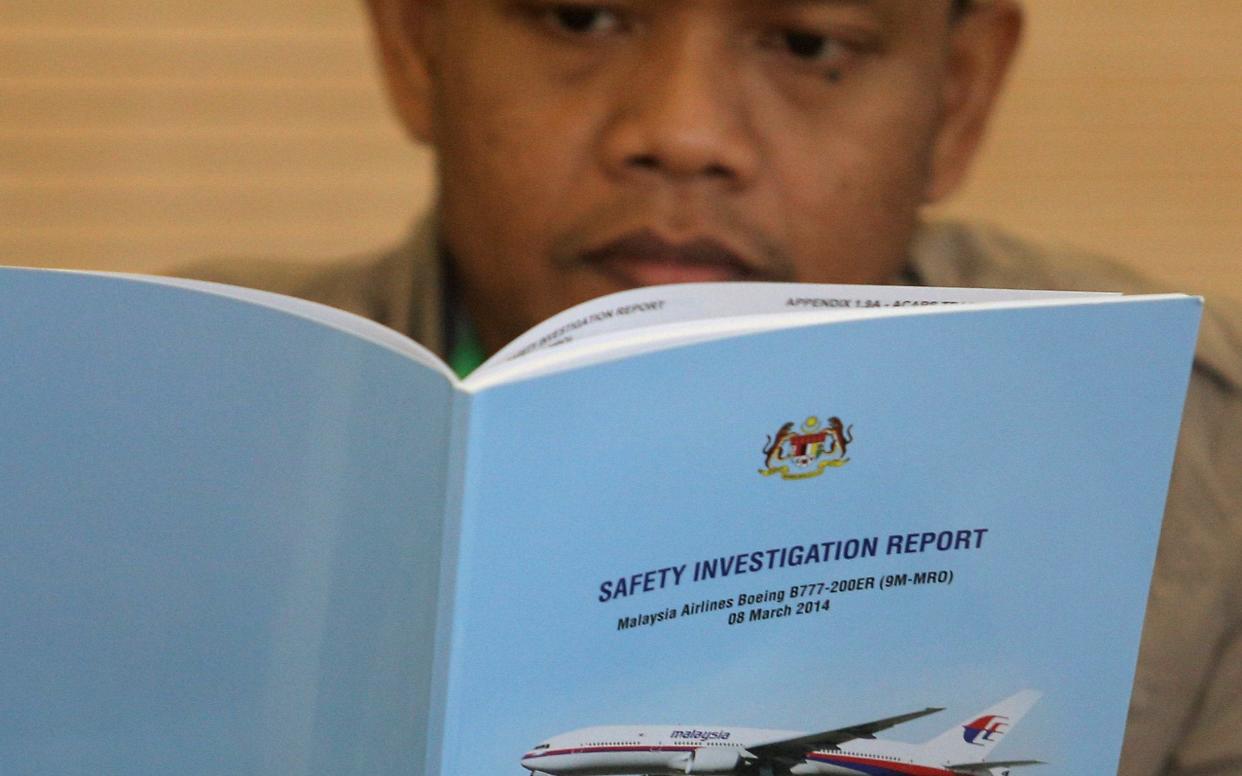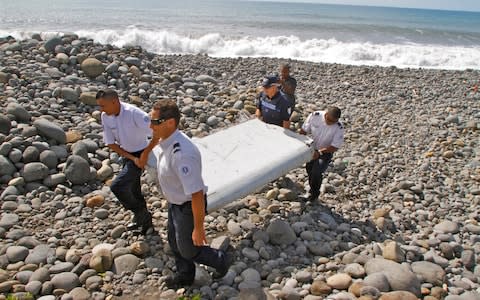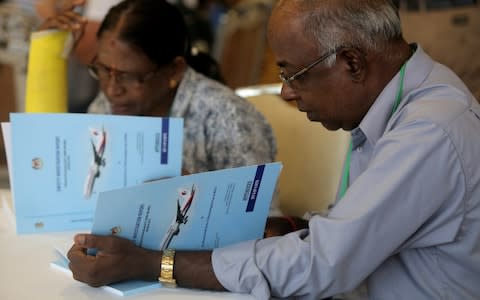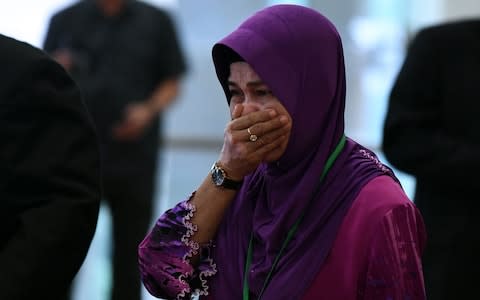MH370: The story so far as Malaysia releases final report into mystery of flight's disappearance

It is arguably the biggest mystery in aviation history: What happened to Flight MH370?
Malaysia is releasing a long-awaited report into the disappearance of the Malaysia Airlines plane, which vanished with 239 aboard en route to Beijing from Kuala Lumpur on March 8, 2014.
Relatives of people aboard the flight, who were given the official investigation team's report on Monday morning at the Malaysian transport ministry, said they hoped it might give them answers.
However, the report, which was due to be released publicly in the afternoon, was unlikely to reveal definitive conclusions about that fateful day four years ago.
Here is everything we know - and don't know - about the unexplained tragedy.
How did it vanish?
Flight MH370 departed Kuala Lumpur at 00:41 local time on Sunday March 8, 2014.
Piloted by Captain Zaharie Ahmad Shah, the plane was expected to fly across the Gulf of Thailand, then over Cambodia, Laos, Vietnam and mainland China, before landing in Beijing just under six hours later at 6.30am.
About 40 minutes into the flight, at 01:19, a co-pilot, believed to be Fariq Abdul Hamid, radios air traffic control: “Alright, good night.” It was the last time authorities heard from the plane.
Two minutes later, the flight fails to check in as scheduled with air traffic control in Ho Chi Minh City, Vietnam. No distress signal is received.
MH370 flight path
Radar shows the aircraft made a sharp left turn, from north-east to almost due west. At 01:38, Vietnamese air traffic control asks other countries and nearby aircraft to attempt to make contact.
At 02:15, MH370’s position is picked up for the final time. Malaysian military radar shows the aircraft is heading north-west across the Andaman Sea.
The alarm is finally raised at 05:30 after hours of confusion and a search and rescue operation is launched, focusing on the South China Sea, south of Vietnam’s Ca Mau peninsula.
At 11.14am, the loss of the flight is confirmed at a press conference.
What might have happened?
No one can say for certain what happened, but the mystery has spawned countless theories - some credible, others less so.
Hypoxia event or onboard accident
The official narrative, from the Malaysian government and the Australian Transport Safety Bureau, posits that the passengers and crew were incapacitated by an unknown “unresponsive crew/ hypoxia event”. Hypoxia is a deficiency of oxygen.
In that scenario, Captain Zaharie, like everyone else on board, was unconscious as the plane flew on autopilot before finally crashing into the sea when it ran out of fuel.
Related theories suggest there was a fire or accident that incapacitated Shah and the cabin crew. That was the belief of Christopher Goodfellow, a former pilot.
"I will maintain my view that the loss of MH370 was due to an accident until it is proved otherwise," Mr Goodfellow wrote in the Telegraph. "As I stated three months ago in my online post, the crew were almost certainly dealing with a major emergency when they made their unannounced turn to the west. Why west? Because they were diverting towards the island of Langkawi, on the west coast of Malaysia. "
Pilots under suspicion
In May, a panel of experts told the Australian TV programme 60 Minutes that the evidence suggested Captain Zaharie Ahmad Shah executed a careful series of manoeuvres to evade detection and ensure the plane disappeared in a remote location.
Martin Dolan, former head of the Australia Transport Safety Bureau, who led the two-year search for the missing plane, said: “This was planned, this was deliberate, and it was done over an extended period of time.”
Two years ago, a study of the flight data found the plane appeared to be out of control when it crashed – rather than being deliberately glided – and that the pilot had not prepared the wing flaps for landing. The analysis indicated the plane dived quickly when it landed and there was no controlled descent.
An initial interim report into the mystery in 2015 looked closely at Captain Zaharie’s background and behaviour in the lead-up to the flight, but found his “ability to handle stress at work and home was good”. The report also stated: “There was no known history of apathy, anxiety, or irritability. There were no significant changes in his lifestyle, interpersonal conflict or family stresses.”
In August 2016, Malaysian officials said Captain Zaharie had plotted a path over the Indian Ocean on a home flight simulator. Then transport minister Liow Tiong Lai said he had used a home-made flight simulator to plot a very similar course to MH370's presumed final route but he emphasised this was just one of thousands of practice routes discovered on Zaharie's hard drive.
"There is no evidence to confirm that (the pilot) flew the plane into the southern Indian Ocean".
The wild theories
Other far-fetched suggestions include the plane being hijacked remotely or being attacked from the ground, with blame being pointed at governments such as the US, Russia and North Korea.
MH370 | The theories
What have the searches found?
There have been two major searches for the doomed aircraft.
The first, carried out by Australia, China and Malaysia, ended in January last year after a fruitless £113 million ($147.06 million) trawl across an area of 46,332 sq miles in the southern Indian Ocean.
“Despite every effort using the best science available, cutting edge technology, as well as modelling and advice from highly skilled professionals who are the best in their field, unfortunately, the search has not been able to locate the aircraft,” the three countries said in a joint statement at the time.
The second, which began in January, was conducted by US-based firm Ocean Infinity. It was called off on May 29 after the privately-funded underwater hunt covered 43,243 sq miles in the southern Indian Ocean.
The search for MH370
The previous administration of Najib Razak had promised up to $70 million to the Texas-based firm if it found the plane. But there were no significant new findings.
The only confirmed traces of the Boeing 777 aircraft have been three wing fragments washed up on Indian Ocean coasts.
The first bit of debris discovered was a flaperon, which was found washed up on Reunion Island in July 2015. French officials said numbers found inside the part match records from a company that manufactured it for MH370. The island lies between Madagascar and Mauritius.

In May the following year, a fragment of plane wing was found in Mauritius, with a "part identifier" allowing investigators to identify the wreckage definitively.
And the following month, a wing flap found on Pemba island, in Tanzania, was confirmed to belong to the missing airliner.
Other parts that are thought to be part of the aircraft include a cabin interior panel, found in Madagascar; engine cowling that washed up in South Africa's Mossel Bay; a main cabin interior panel that cropped up in Rodrigues Island in Mauritius; a horizontal stabilizer found on a beach in Mozambique; and a flap track fairing that was also discovered on a Mozambique beach.
What will the report say?
Anthony Loke, Malaysia's transport minister, said the investigation team would brief families of those aboard on the report in a closed-door briefing. A news conference will then follow in the afternoon.
"Every word recorded by the investigation team will be tabled in this report," he told reporters, adding that a news conference would follow the closed-door briefing.

"We are committed to the transparency of this report," Loke added. "It will be tabled fully, without any editing, additions, or redactions."
The report will be put online, with hard copies distributed to families and accredited media, among others, Loke said, adding: "The whole international community will have access to the report." It will also be presented to both Houses of Parliament on Tuesday.
Arriving at the transport ministry on Monday to receive the report, Nurlaila Ngah, whose husband Wan Swaid Wan Ismail was an MH370 crew member, said she was hoping for a "solid answer" about what happened that could give relatives some closure.

"In the airline industry, tragedies happen but there are clues as to what could have happened," she told AFP. "It makes no sense if they (the investigators) say there are no hints as to what could have happened."
But Calvin Shim, whose wife was a stewardess on the flight, was sceptical the report would tell families anything new after more than four years of fruitless searching.
"I do not expect any fresh revelations from this report," he said. "The black box has not been found. The plane wreckage has not been found."
Families weep after receiving final report on MH370. “There’s no conclusion” pic.twitter.com/u40tuFuzM1
— David Lipson (@davidlipson) July 30, 2018
He had said previously he was concerned that the accident report would not include key details such as the plane's full cargo manifest and the results of a separate investigation by Malaysian police.
Voice 370, a group representing the relatives, has previously urged the Malaysian government for a review of the flight, including "any possible falsification or elimination of records related to MH370 and its maintenance".
What next?
For the moment, the families can only pray that a firm clue as to the aircraft's whereabouts emerges.
Mahathir Mohamad, Malaysia's Prime Minister, has said the country would consider resuming the search if new clues came to light, and Ocean Infinity CEO Oliver Plunkett hoped the company would be able to offer its services again in a future operation.
Michael McCormack, Australia's Deputy Prime Minister, said the search had tested the limits of technology and capacity of experts and people at sea.
It would only resume if there was "credible evidence which identifies a specific location of the missing aircraft".
"We will always remain hopeful that one day the aircraft will be located," Mr McCormack's office said in May.

